Liebherr SICN3356LH, SICBN3366RH, SICN3366RH Installation Guide
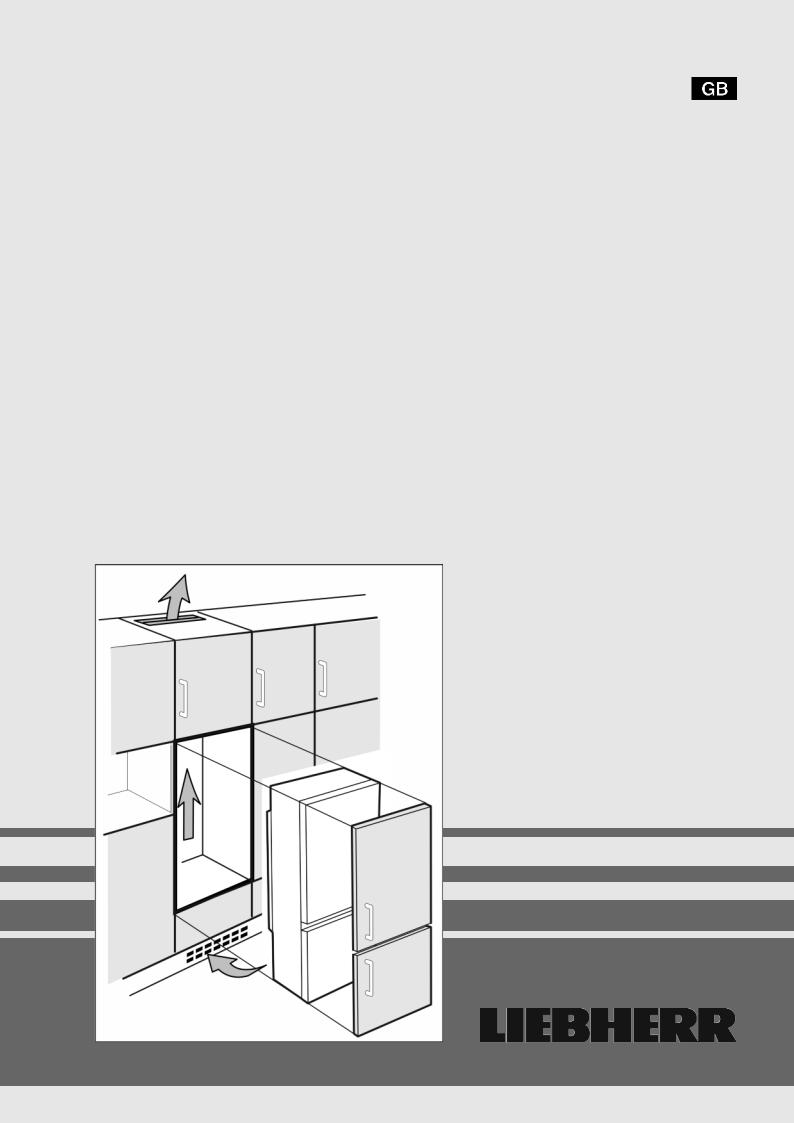
Installation instructions
Combined fridge-freezer for integrated use, door-on-door
140114 7085634 - 01
(S)IC.../ (S)ICB.../ ICU... ... LC/ LP

General safety information
Contents |
|
|
1 |
General safety information................................... |
2 |
2 |
Transporting the appliance................................... |
2 |
3 |
Installing the appliance......................................... |
2 |
4 |
Appliance dimensions........................................... |
3 |
5 |
Recess dimensions............................................... |
3 |
6 |
Unit door................................................................. |
4 |
7 |
Ventilation of the kitchen unit............................... |
4 |
8 |
Changing over door hinges.................................. |
5 |
9 |
Water connection................................................... |
5 |
10 |
Installing the appliance in the recess.................. |
6 |
11 |
Disposing of packaging........................................ |
6 |
12 |
Connecting the appliance..................................... |
6 |
The manufacturer works constantly on the further development of all the types and models. Therefore please understand that we have to reserve the right to make design, equipment and technical modifications.
To get to know all the benefits of your new appliance, please read the information contained in these instructions carefully.
The instructions apply to several models. Differences may occur. Text relating only to specific appliances is marked with an asterisk (*).
Instructions for action are marked with a  , the results of action are marked with a
, the results of action are marked with a  .
.
1 General safety information
-Only install, connect and dispose of the appliance according to the instructions. Take particular note of “Recess dimensions” (see 5) and “Ventilation of the kitchen unit” (see 7) .
-The socket must be easily accessible so that the appliance can be quickly disconnected from the supply in an emergency. It must be outside the area of the rear of the appliance.
|
DANGER |
identifies a situation involving direct |
|
|
danger which, if not obviated, may |
|
|
result in death or severe bodily |
|
|
injury. |
|
WARNING |
identifies a dangerous situation |
|
|
which, if not obviated, may result in |
|
|
death or severe bodily injury. |
|
CAUTION |
identifies a dangerous situation |
|
|
which, if not obviated, may result in |
|
|
minor or medium bodily injury. |
|
NOTICE |
identifies a dangerous situation |
|
|
which, if not obviated, may result in |
|
|
damage to property. |
|
|
|
|
Note |
identifies useful information and tips. |
2 Transporting the appliance
 CAUTION
CAUTION
Risk of injury and danger of damage as a result of incorrect transport!
u Transport the appliance in a packed condition. u Transport the appliance upright.
u Do not transport the appliance without assistance.
3 Installing the appliance
 WARNING
WARNING
Risk of fire due to short circuit!
If the mains cable/connector of the appliance or of another appliance touch the rear of the appliance, the mains cable/ connector may be damaged by the appliance vibrations, leading to a short circuit.
u Stand the appliance so that it is not touched by connectors or main cables.
u Do not plug the appliance or any others into sockets located near the rear of the appliance.
 WARNING
WARNING
Fire hazard due to dampness!
If live parts or the mains lead become damp this may cause short circuits.
u The appliance is designed for use in enclosed areas. Do not operate the appliance outdoors or in areas where it is exposed to splash water or damp conditions.
u Only use the appliance when it is installed.
 WARNING
WARNING
Fire hazard due to refrigerant!
The refrigerant R 600a is environmentally friendly but flammable. Escaping refrigerant may ignite.
u Do not damage the piping of the refrigeration circuit.
 WARNING
WARNING
Fire hazard and danger of damage!
u Do not place appliances emitting heat e.g. microwaves, toasters etc. on the appliance!
NOTICE
Risk of damage from condensation!
If your appliance is not a Side-by-Side (SBS) appliance:
u do not install the appliance directly next to another fridge/ freezer.
If your appliance is a Side-by-Side (SBS) appliance:
u install the SBS fridge-freezer combination according to the accompanying sheet.
q In the event that the appliance is damaged, contact the supplier immediately before connecting to the mains.
q The floor at the site must be flat and level.
q Do not install the appliance in a location where it is exposed to direct radiation of the sun, next to a cooker, heater and similar.
q Do not install the appliance alone: it is best to work together with two or more people.
2 |
* Depending on model and options |
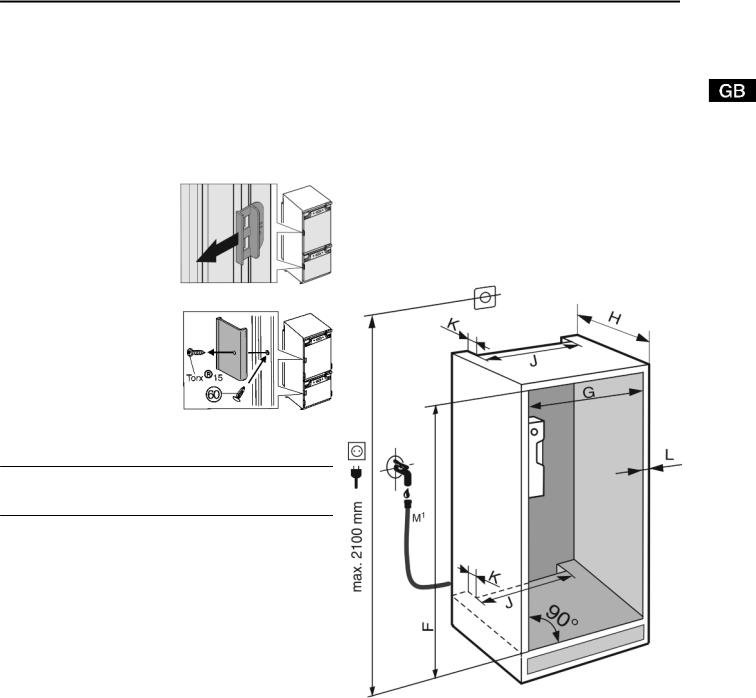
Appliance dimensions
q The installation area of your appliance must demonstrate, per 8 gof refrigerant R 600a, a volume of 1 m3 according to the EN 378 standard. If the installation area is too small, an inflammable gas-air mixture may arise as a result of a leakage in the refrigeration circuit. Information as to the refrigerant amount can be found in the type plate on the inside of the appliance.
q If the appliance is installed in a very damp environment, condensed water may form on the outside of the appliance. Always make sure that there is good ventilation - both at air inlet and outlet - at the site of installation.
If the transport lock is inserted on the door: u Pull off red transport lock.
If the transport lock is screwed onto the door: u Unscrew red transport lock.
Close the freed retaining hole with plugs (60).
After installation:
u Remove protective films, adhesive tapes and transport lock parts etc.
Note
u Clean the appliance (see Operating Instructions, Chapter "Cleaning the appliance").
4 Appliance dimensions
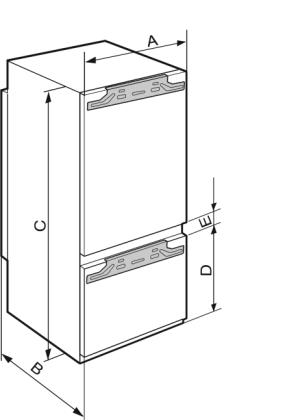 Fig. 1
Fig. 1
|
A |
B |
C |
D |
E |
|
(mm) |
(mm) |
(mm) |
(mm) |
(mm) |
ICP 29.. |
559 |
544 |
1572 |
549 |
15 |
ICBP 32.. |
559 |
544 |
1770 |
549 |
15 |
ICU 33.., ICUN 33.., |
559 |
544 |
1770 |
695 |
15 |
ICP 33.., ICNP 33.., |
|
|
|
|
|
ICN 33.., SICN 33.., |
|
|
|
|
|
ICBN 33.., SICBN 33.. |
|
|
|
|
|
5 Recess dimensions
The appliance is built-in and therefore completely enclosed by a kitchen unit. The kitchen unit concerned must be built exactly to the prescribed dimensions and allow for sufficient ventilation, both at air inlet and outlet, to ensure proper appliance operation.
Fig. 2
M1) : For N3366 only (see 9)
|
F |
G |
H |
J |
K |
L |
|
(mm) |
(mm) |
(mm) |
(mm) |
(mm) |
(mm) |
ICP 29.. |
1574 |
560 |
min. |
min. |
min. |
max. |
|
— |
— |
560 |
500 |
40 |
19 |
|
1590 |
570 |
|
|
|
|
ICU 33.., |
1772 |
560 |
min. |
min. |
min. |
max. |
ICUN 33.., |
— |
— |
560 |
500 |
40 |
19 |
ICP 33.., |
1788 |
570 |
|
|
|
|
ICNP 33.., |
|
|
|
|
|
|
ICN 33.., |
|
|
|
|
|
|
SICN 33.., |
|
|
|
|
|
|
ICBP 32.., |
|
|
|
|
|
|
ICBN 33.., |
|
|
|
|
|
|
SICBN 33.. |
|
|
|
|
|
|
* Depending on model and options |
3 |
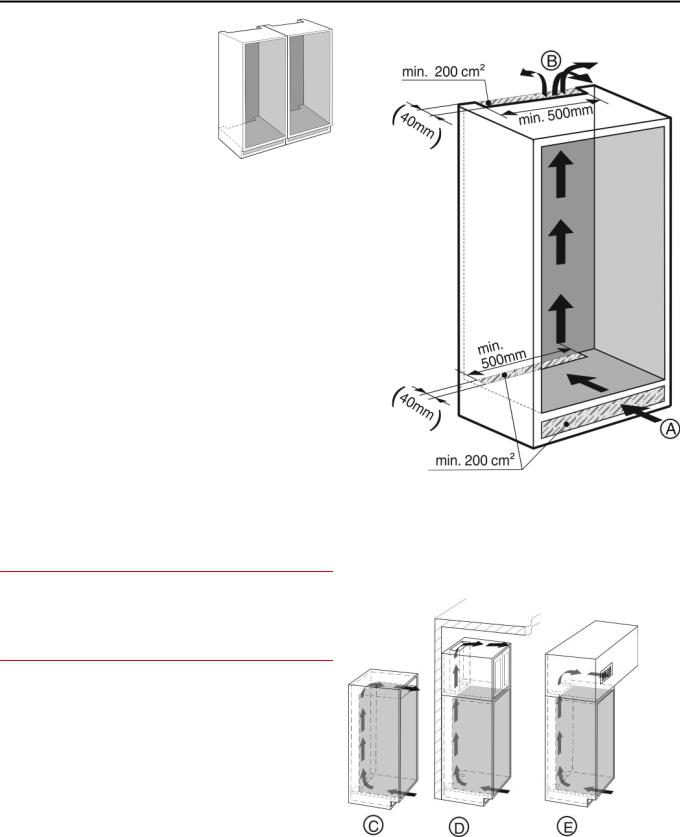
Unit door
u In the case of Side-by-Side installation, two appliances next to one another, build the appliances into separate kitchen units.
u Check the wall thickness of the adjoining cabinets: it must be min. 16 mm.
u Only install the appliance in robust, stable kitchen units. Secure the units against tipping.
u Align the kitchen unit using a spirit level and marking square and if necessary compensate with shims.
u Ensure that the floor and walls of the unit are at right angles to one another.
6 Unit door
-Two doors are required for this kitchen unit: the upper for the refrigerator and the lower for the freezer compartment.
-The doors must be minimum 16 mm and maximum 19 mm thick.
-When both doors are closed, the gap between the upper and lower door must be at least 3 mm high.
-The gap between unit doors must be at the same level as the gap between the appliance doors.
-There must be a gap of minimum 3 mm in height between the door and the unit door located above it (if one exists).
-The width of the unit doors depends on the style of the kitchen and on the gap size between the door panels of the cabinet. Generally, there should remain a vertical gap of 3 mm between the unit doors.
-The top edges of the upper and lower doors should be on a level with the doors of the adjoining cabinet (or cabinets), if there are other cabinets.
-The unit doors must be planar and mounted stress-free.
NOTICE
Risk of damage from over-heavy unit door!
If the unit door is too heavy, damage to the hinges and resulting impairment of function cannot be excluded.
u Before mounting the unit door, make sure that the door does not exceed the approved unit door weight.
Appliance type |
Maximum unit door weight (kg) |
|
|
Refrigerator |
Freezer compart- |
|
compartment |
ment door |
|
door |
|
ICP 29.. |
13 |
12 |
ICU 33.., ICUN 33.., |
14 |
12 |
ICP 33.., ICN 33.., |
|
|
SICN 33.., |
|
|
ICNP 33.. |
|
|
ICBP 32.. |
19 |
12 |
ICBN 33.., |
20 |
12 |
SICBN 33.. |
|
|
7 Ventilation of the kitchen unit
Fig. 3
-There must be an effective ventilation shaft of at least 200 cm2 per appliance at the air inlet Fig. 3 (A) and outlet
Fig. 3 (B) vent.
-The principle applies that the larger the ventilation shaft, the more energy-saving the operation of the appliance.
-The depth of the ventilation shaft at the back of the cabinet must be min. 40 mm.
- |
Fig. 4 |
The upper ventilation shaft can either be positioned directly |
|
|
above the appliance with an optional ventilation grille |
|
Fig. 4 (C), close to the ceiling above the unit Fig. 4 (D) or as |
|
an air outlet opening in a false ceiling Fig. 4 (E). |
4 |
* Depending on model and options |
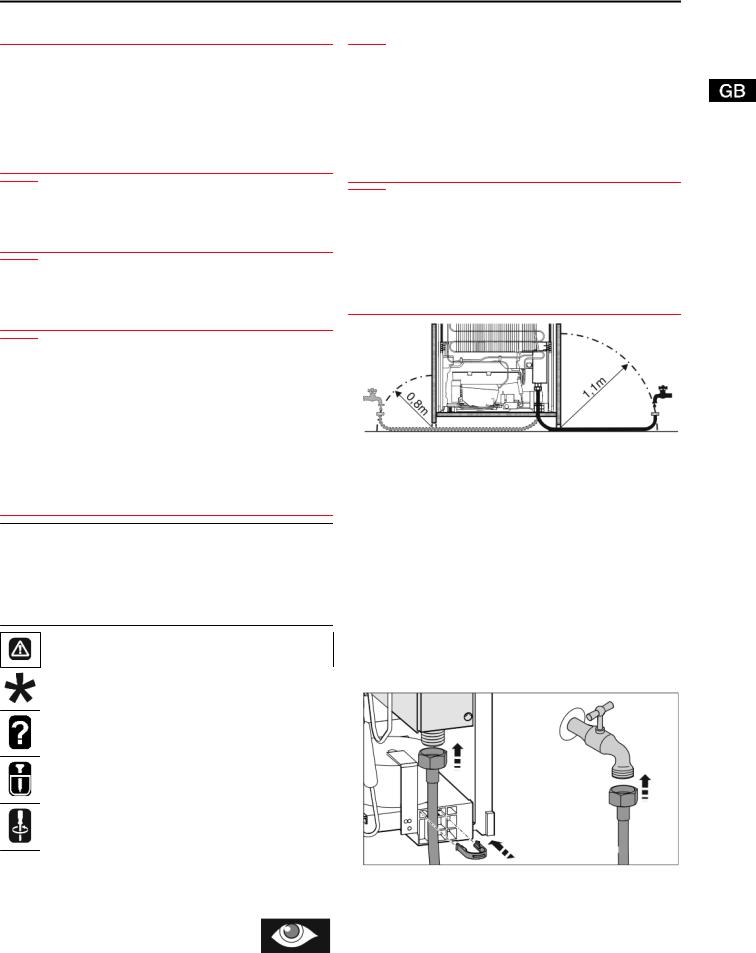
Changing over door hinges
8 Changing over door hinges
NOTICE
Risk of condensation damage for Side-by-Side appliances! Certain appliances can be set up as Side-by-Side combinations (two appliances next to each other).
If your appliance is a Side-by-Side (SBS) appliance:
u Set up the SBS combination in accordance with the enclosed document.
If the positioning of the devices is stipulated: u Do not change the door hinges over.
 CAUTION
CAUTION
Risk of injury if soft stop contracts!
u Carefully remove the soft stop mechanism.
 CAUTION
CAUTION
Risk of injury if hinges fold! u Leave hinges open.
 WARNING
WARNING
Risk of injury due to the door dropping out!
If the fastening parts are not screwed into place firmly enough, the door may drop out. This may lead to severe injuries. What is more, the door may not close and therefore the appliance may fail to cool properly.
u Screw the hinges and the ball journal of the soft stop mechanism firmly into place, with 4 Nm.
u Screw the holder of the soft stop mechanism firmly into place, with at least 3 Nm.
u Check all of the screws and retighten if necessary.
Note
The door hinges can only be changed over if there is sufficient space towards the top to pull out the hinge mounting bracket and to mount it again on the other side. This is generally not the case after installation in the recess.
u Change the hinges over before the appliance is installed in the recess.
There is a risk of injury during this stage! Please observe the safety instructions!
The instructions apply to several models. Only carry out this step if it is relevant for your appliance.
Choose between the alternatives given.
Loosen the screws only, do not undo them all the way.
Check the screws and tighten if necessary.
u While changing over the door hinges, observe the safety instructions above and also the information in the symbols key.
Change the hinges over as shown at the end of the book.
9 Water connection*
 WARNING
WARNING
Danger of electric shock!
u Disconnect the appliance by unplugging it before you connect it to the water line.
u Shut off the water supply before you connect the water feed lines of the IceMaker.
u The connection to the drinking water system may be carried out only by a qualified gas fitter and plumber.
 WARNING
WARNING
Risk of poisoning!
u The water quality has to comply with the drinking water ordinance of the respective country (e.g. 98/8
u The IceMaker serves exclusively for making ice cubes in household quantities and has to be operated with water suitable for the purpose.
Fig. 5
-The water pressure has to be between 0.15 MPa and 0.6 MPa (1.5 bar - 6 bar).
-The water supply to the appliance must be via a cold water pipe which withstands the operating pressure and complies with the hygiene regulations.
Use the accompanying stainless steel hose (1.5 m). Do not reuse old hoses. A 3 m hose is available from the customer service department and has to be fitted by an expert.
In the hose connecting piece is a sieve with seal.
-Between the hose and the domestic water connection there has to be a stopcock to interrupt the water supply in case of need.
-All the fixtures and fittings used for water supply have to comply with the applicable regulations of the respective country.
-Do not damage or kink the water inlet pipe when installing the appliance.
Fig. 6
The solenoid valve is at the bottom back of the appliance. It has a metric R3/4 connecting thread.
u Connect the straight part of the stainless steel hose to the solenoid valve.
u Fix the stainless steel hose to the housing with the locking hook.
* Depending on model and options |
5 |
